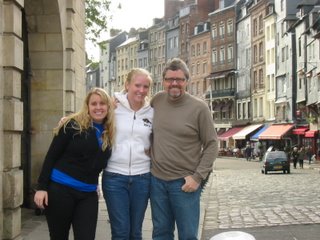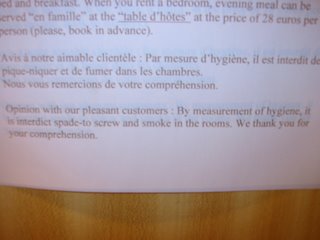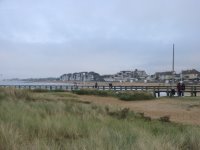A Long Weekend in Normandy 


We have just returned from our first real trip into the country over a four-day weekend. We chose Normandy because it is a relatively short and easy drive from Paris and because it has so much to offer in history, food and sights. We covered almost 1,000 kilometres, but stayed in the same chambre d’hote (B&B) for all three nights. It turned out to be the last weekend of "l 'été indien", with temperatures close to 20 degrees.
Normandy Day 1: Down on the ferme
On Saturday, we were out of Paris and well on our way so quickly that we headed off the autoroute onto lesser highways and found several interesting towns along the way. We ate a pique-nique lunch (more about that later) next to a fifteenth century clock tower that still showed many bullet marks from World War II.

Travel times are always shorter than expected here, so we used our early arrival to visit Deauville, a very attractive beach resort town know for its large casino that is one of the closest to Britain and is favored by English day trippers. Sort of like Monte Carlo for the welly-boot crowd.
We walked the beach boardwalk with its line of changing huts with the names of actors on each door, impressed by the famous people the resort seems to draw,  until we realised that many of those named have long-since passed on. I guess the idea is to offer the common folks the chance to slip out of their clothes in the Tom Cruise changing room. We didn’t ask the price – the cost of a coffee in the café had already been enough to tell us we won't be spending our summers there.
until we realised that many of those named have long-since passed on. I guess the idea is to offer the common folks the chance to slip out of their clothes in the Tom Cruise changing room. We didn’t ask the price – the cost of a coffee in the café had already been enough to tell us we won't be spending our summers there.

Our B&B, which was located in the country (no sirens and revving engines!) was quite interesting, a rather remote farm with horses, ducks, and a couple of Jack Russell terriers. In fact I think the farming is more of a hobby, than a money-making venture. It was run by a charming older hippie couple who, unlike what we’ve observed at other B&Bs we’ve stayed at, appeared to share the duties of running the operation. He also runs a hair dressing shop just behind the kitchen and does metalwork. The house was a strange mix of traditional and modern, with a long buffet made out of post office safes, china cabinets from hospital storage cabinets and overhead lamps from operating rooms. A bit weird but nonetheless quite well-done. As we arrived late in the day on Saturday, we decided to take advantage of the table d'hôte (full course meal) available to their guests for a pretty reasonable fee and prepared by the ‘man of the house’ who then led the conversation over din ner. It was an excellent seafood dinner all grilled over a wood fire. The challenge of course was to dine with eight virtual strangers – all of whom spoke only French. I’m sure Brian must have had a migraine by the end of the evening from carrying the conversation, particularly after having to translate the host’s risqué jokes
d'hôte (full course meal) available to their guests for a pretty reasonable fee and prepared by the ‘man of the house’ who then led the conversation over din ner. It was an excellent seafood dinner all grilled over a wood fire. The challenge of course was to dine with eight virtual strangers – all of whom spoke only French. I’m sure Brian must have had a migraine by the end of the evening from carrying the conversation, particularly after having to translate the host’s risqué jokes for the girls. We stayed three nights and I must say I looked forward each morning to breakfast (must have been the country air): croissants, bread, cheese, three types of jam, butter, café au lait, hot chocolate, yogurt…).
for the girls. We stayed three nights and I must say I looked forward each morning to breakfast (must have been the country air): croissants, bread, cheese, three types of jam, butter, café au lait, hot chocolate, yogurt…).
One lesson we learned – if you’re going to do translations using those Internet automatic translation engines (e.g. Babelfish), you should probably get them verified by someone who knows the language to ensure the translations are not too literal. Our hosts, not wanting food in the rooms, posted this notice that turned the hyphenated verb for “to picnic” into something quite different – “pique” meaning a type of shovel and “niquer” … you’d better read for yourself.
For those having trouble reading the image: here is the transcript: "Opinion with our pleasant customers: By measurement of hygiene, it is interdict spade-to screw and smoke in the rooms. We thank you for your comprehension."
Will post more soon on the rest of our trip.
 One day, we took the fairly long drive (90 minutes) to Mont Saint Michel, the famous Abbey that is probably one of the most photographed places in
One day, we took the fairly long drive (90 minutes) to Mont Saint Michel, the famous Abbey that is probably one of the most photographed places in  to buy souvenirs, although Brian was strongly tempted by a full-size suit of armour – perfect for that empty corner of the dining room. Hungry by now, we looked for an appropriate restaurant. There is always a local speciality that one is supposed to try and in Mont Saint Michel it is omelettes. We decided to pass up the famous restaurant Mere Poulard (home of the $30 omelette) which had a crowd waiting anyway and we settled instead on toasted panini sandwiches and McCain french fries in a casse-croute. Hardly gourmet, but the Belgian draft beer (brewed by monks, you know) added a touch of historical authenticity.
to buy souvenirs, although Brian was strongly tempted by a full-size suit of armour – perfect for that empty corner of the dining room. Hungry by now, we looked for an appropriate restaurant. There is always a local speciality that one is supposed to try and in Mont Saint Michel it is omelettes. We decided to pass up the famous restaurant Mere Poulard (home of the $30 omelette) which had a crowd waiting anyway and we settled instead on toasted panini sandwiches and McCain french fries in a casse-croute. Hardly gourmet, but the Belgian draft beer (brewed by monks, you know) added a touch of historical authenticity. We decided to take back roads on the return trip to our chambre d’hôte, travelling through Suisse Normande, so named because the hills and valleys of rich farmland are similar to
We decided to take back roads on the return trip to our chambre d’hôte, travelling through Suisse Normande, so named because the hills and valleys of rich farmland are similar to 
 On the next day we headed back to
On the next day we headed back to  We headed onwards to the coast and stopped in Honfleur. This beautiful port town sits at the mouth of the River Seine where it flows into the Channel. It was a centre of impressionist painting and the harbour is subject of many well-known artworks. More important for Canadians perhaps is the fact that Samuel de Champlain sailed from Honfleur in 1608 to found
We headed onwards to the coast and stopped in Honfleur. This beautiful port town sits at the mouth of the River Seine where it flows into the Channel. It was a centre of impressionist painting and the harbour is subject of many well-known artworks. More important for Canadians perhaps is the fact that Samuel de Champlain sailed from Honfleur in 1608 to found 
























